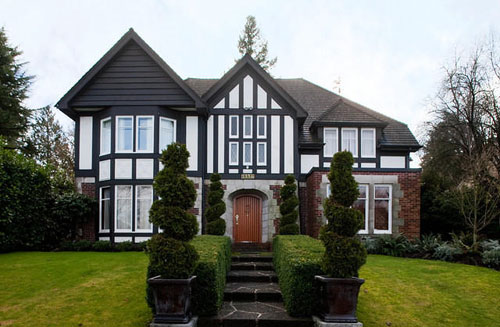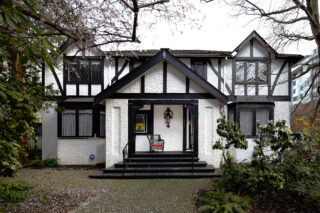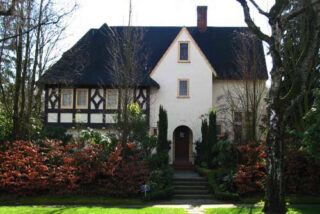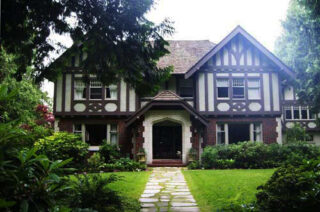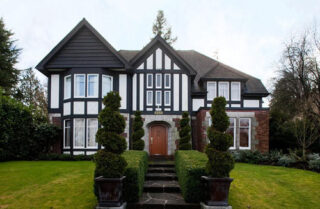Earlier pre-1920s Tudor Revivals generally had wood cladding on the main floors with rough-cast stucco and half-timbering on the upper stories. After the war, masonry veneering of brick or stone (usually granite) covered the main floor, with stucco and robust detail above. From the late 1930s on, the Tudor exteriors were primarily covered in stucco with a vestigial half-timbering left in the gables. Decorative medieval wood details like quatrefoils in panels became part of the half-timbering along with wide bracketed eaves. Windows are usually multi-paned with wooden muntins, or sometimes leaded glass in diamond panes.
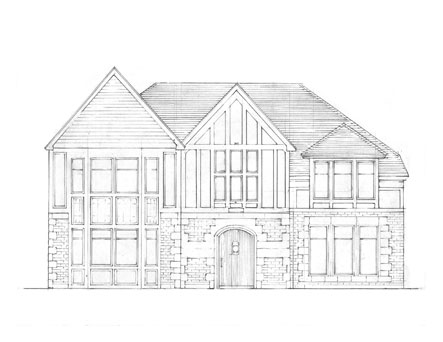
Click on the diagram or expand the term index to learn more about the features.
Gable Roof
A pitched roof that ends in a gable (the triangular portion of a wall defined by the sloping edges of the roof and a horizontal line between the eave line).
Half-timbering
Decorative trim boards used in conjunction with stucco cladding to evoke medieval half-timbering.
Hipped Roof
A hip (or hipped) roof slopes down to the eaves on all four sides. Although a hip roof has no gable ends, it may have dormers or connecting wings with gables. When the building is square, the hip roof is pointed at the top like a pyramid. When the building is rectangular, the hipped roof forms a ridge at the top.
Quoins
The dressed stones at the corners of buildings, usually laid so their faces are alternately large and small. Also used around doorways in French and Tudor Revival houses.
Form
Houses with steeply pitched side-gabled or hipped roofs, picturesque profiles, projecting gabled bays or cross gables with half-timbering, and tall chimneys; multiple window assemblies usually include leaded glass, often in diamond patterns. Many pre-World War 1 examples had stone foundations, wooden cladding (shingles or lap siding) on the main floor and roughcast stucco in the half-timbered gable. They are very similar to Arts & Crafts Style houses, but show more gable and half-timbering to the street.
Background
The Tudor Revival style is inspired by English architecture of the late medieval period. Its designs draw from architecture of both cottages and grander manor homes. The earliest examples in North America appeared in the late nineteenth century but the style grew most popular in Vancouver in the interwar period (1920 – 1940). Its rise was driven by the romanticism and nostalgia that characterized most of the Revival styles at this time. Tudor Revival homes continued to be built throughout the twentieth century. In many respects, it is similar to the Arts and Crafts style. However, Tudor Revival style has more vertical orientation and more half-timbering.
Details
- Steeply pitched roof
- Usually side-gabled
- Prominent cross-gables
- Tall, narrow, multi-pane windows
- Windows usually in multiple groups
- Massive chimneys with decorative chimney pots
- Decorative half-timbering
Distinguished from Arts and Crafts houses by:
- Massive chimneys on exterior walls
- Showing more gable to street than Arts and Crafts
- More abundant half-timbering, often entire upper portion of home
